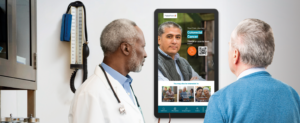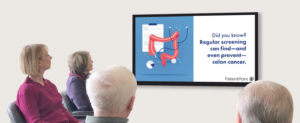Health equity, ensuring equal opportunities for optimal health, is a top priority in healthcare. In the complex landscape of cancer care, where preventive screenings are vital and expenses are high, achieving health equity is a challenge. All patients deserve quality, accessible care; by providing relevant, easy-to-understand patient education at the right moments, you can empower them to become shared-decision makers in their treatment and improve health equity.
Easy-to-understand education improves health literacy

Patients with low health literacy struggle to understand their conditions and treatments—often to the detriment of their own health. Easily accessible and understandable patient education can bridge health literacy gaps caused by language, income and other barriers.
Health information in the waiting room should use plain language rather than medical jargon and be available in the predominant language(s) of your patient population. Health education videos that play on a waiting room TV combine written, spoken and visual information to improve comprehension and retention of information. Waiting room education prepares patients of all backgrounds to have conversations with their doctor—because they know the questions to ask and the symptoms or side effects to bring up.
Extend education opportunities into the exam room with interactive information. Exam room screens should, at a minimum, apply to the most common cancers that your practice treats and have information for various stages—initial diagnosis, managing symptoms, coping with side effects from cancer care and survivorship. Interactive engagement solutions let patients find articles, videos, inspiring patient stories, community resources and other information relevant to their personal care journey. And even if these patients are unsure where to start, providers can introduce the education as part of teaching moments during the appointment.
Want more tips for increasing health literacy? Check out this article.
Accessible education empowers patients to make decisions
The right education should speak to your entire patient population—with content that’s relevant to patients of varying needs. In addition to using simple language in your education, you can accomplish this by featuring imagery and photography on your digital signage that represent your diverse patient population. Representation helps them feel seen and can inspire them to make changes in their healthcare. Continued education then encourages them to be active at key decision-making moments—in the waiting room and exam room. Effective digital signage in these areas uses active language that provides a clear call to action like recommending patients sign into their patient portal to review appointment notes, take their full course of therapy to ensure best results, speak with their doctor about side effects and/or request preventive screenings for other cancers.
To have the most success with your patient engagement strategy, you need to get your clinical staff on board. Remind them about the importance of collaborative decision-making and give them tips for driving patient action and achieving practice initiatives via email. Or even better, communicate with your team while they relax in the break room or walk between appointments using an interactive screen that displays non-disruptive messages to your team.
Health education boosts preventive screenings

As you know, scheduling a cancer screening is crucial because it can be the difference between detecting cancer early or finding it at a later stage when it’s more difficult to treat. Patient education programs in the waiting room and exam room should include preventive screening information that highlights the top risk factors for certain cancers and encourages patients to talk to their doctor. Don’t assume patients are already aware of the benefits; their experiences can largely dictate their opinions toward screenings.
In particular, when a patient has already been diagnosed, undergoing treatment or is a cancer survivor, screening for other cancers may not be top of mind. That’s why it’s important to reinforce that prevention of all cancers is a critical and ongoing component of their healthcare.
By providing individuals with the knowledge and tools to navigate the complexities of cancer prevention and treatment, you can ensure every individual, regardless of their background, has an equal opportunity for optimal cancer outcomes.
Our in-office devices are proven to increase screenings and accordingly health equity. Learn how we can boost your cancer screenings in our case study, “Improving Health Outcomes with PatientPoint.”

